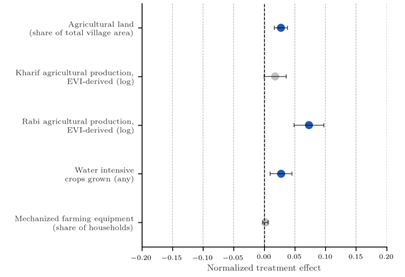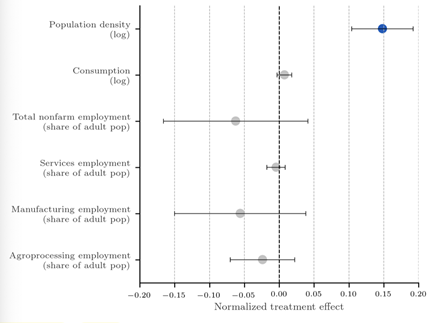Evidence from canals in India shows that labour mobility is a key channel to agricultural growth. This article shows that villages with access to canal water have persistently higher agricultural yields and higher population density for decades after canals are built. While the non-farm share of the economy is no different in canal and non-canal villages, nearby towns grew more quickly after canals were built. Structural transformation has taken place primarily through the migration of people to towns.
The structural transformation of an economy out of agriculture is perhaps the most universal fact of development. Every country in the world that has experienced substantial economic growth has also seen a drastic fall in the share of its workers employed in agriculture.
The mechanism for this pattern has been of interest to development economists for generations (see Schultz 1953, Lewis 1954, Johnston and Mellor 1961). Structural transformation and development surely move together, but the direction of causality and the geographic scale at which it operates are still deep questions in the field. An improved understanding of this relationship is highly relevant for policy as well – do poorer countries need to focus on improving productivity in agriculture, trusting that advanced industries will follow? Or conversely, does agricultural productivity change follow development in the other sectors, motivating emphasis on the manufacturing and services sectors? Will investments in agriculture cause villages to become centres for microenterprise and larger-scale industry?
Unique features of India’s canal network
In a new working paper (Asher et al. 2022), we study one of the largest agricultural investments in human history – India’s vast canal network. Built through the 19th and 20th centuries, India’s canals stretch some 300,000 kilometres, and deliver water to over 100,000 villages. Access to canal irrigation gives farmers a reliable water source, which is particularly valuable in the winter cropping season when rains are scarce.
A challenge in studying the effects of agricultural productivity change in the long run is that agricultural technology tends to diffuse across space. As high-yield seeds or chemical fertilisers prove their worth, more and more farmers adopt them, making it harder to find a ‘control’ group, especially in the long run. Canals, on the other hand, are fixed in space – they only ever serve a particular area, making it possible to clearly identify ‘treated’ and ‘untreated’ places decades and even centuries after their construction.
Additionally, because canals in India were mostly built long ago (most canals in our sample were completed before 1980), the effects we observe today are long-term: they reflect the equilibrium outcome of a permanent shock to agricultural productivity. They thus provide us a unique opportunity to study how agricultural productivity change affects the spatial distribution of both people and firms in the long run, after both have had plenty of time to relocate.
Indeed, the movement of people into canal regions was a central issue faced by the British administrators who oversaw the construction of canals across the subcontinent in the 19th and first half of the 20th century. Maclean (1885) attributes a doubling of the population and the “most prosperous condition” of agriculture and commerce in the Godavari valley to the “extension of irrigation by canals.” The Punjab Canal Colonies attracted over 1 million migrants to newly arable lands, leading colonial administrator James Douie to state that “[settlement] is the handmaiden of irrigation” (Douie 1914).
Identifying the effects of irrigation canals
To study the long-run effects of canals, we matched geospatial data on every medium and large canal in India to a wide range of administrative and satellite data at high geographic resolution. We use the gravity-driven nature of canals to identify the direct effect of irrigation: since water only flows downhill, farms below the canal are much more likely to benefit from the irrigation network. This motivates a regression discontinuity analysis1 – comparing places with elevations just above the canal to places with elevations just below. We restrict the sample to villages with otherwise highly similar geographic characteristics, to ensure that we are not comparing rugged mountainsides to fertile valleys.
Sure enough, below-canal villages today report substantially higher canal irrigation and higher agricultural yields (proxied by a satellite vegetation index), particularly in the relatively dry winter (rabi) cropping season (see Figure 1). The natural experiment holds up, and canal-irrigated villages have sharply higher agricultural productivity, even many decades after canal construction.
Figure 1. Treatment effects from different agricultural outcomes
Note: The figure shows regression discontinuity results for key agricultural outcomes. Blue points indicate normalised treatment effects that are statistically different from 0, and grey dots indicate insignificant results.
Interestingly, these canal-irrigated villages show no sign of structural change; we estimate a precise zero effect of canals on the non-farm share of the labour force (see Figure 2). However, they do have a substantially higher population, and specifically, a higher landless population. The results are similar in an analysis of spillovers that compares the above-canal regions to geographically similar places further away: above-canal villages do not seem to be experiencing substantial spillovers2 in either the farm or the non-farm sector.
Figure 2. Effect of canals on non-farm outcomes
Note: The figure shows regression discontinuity results for the main non-farm outcomes. Blue points indicate normalised treatment effects that are statistically distinguishable from 0, and grey dots indicate insignificant results.
Labour mobility explains productivity gains
Long-run labour mobility is the best explanation for our findings. Over the long run, people are mobile, especially landless labourers. Even a small rate of internal migration can result in substantial population flows over the decades-long period that we study. Canal irrigation raises agricultural productivity, initially putting upward pressure on agricultural wages. Over the long run, new workers move into irrigated regions until wages are again equalised with the broader economy.
Land, in contrast to labour, is a fixed factor – and indeed we find that landowners have higher consumption in canal villages (but the landless do not). This is a standard result in public finance – that subsidies and taxes fall on the fixed factor. The higher short-run returns to labour (from the extra demand for workers in canal villages) are eventually wiped away by the arrival of new workers, but the returns to land stay high, because total agricultural area can only be marginally increased.
However, this is not the end of the story. In a difference-in-difference3 analysis, we study whether towns grew more in canal regions in the decade after canals were built. To do this, we take advantage of a long-run time series of town populations going back to 1911 – unfortunately there is no long-run time series data on any of our other outcomes. We find that towns in proximity to canals grew substantially faster following canal completion.
The magnitudes of the population movements implied by our estimates are striking. India’s canals have drawn almost 45 million additional people to canal regions – about 5 million people to regional towns and 40 million people to villages directly irrigated by canals. In the end, this can account for a substantial degree of structural change: a back-of-the-envelope calculation suggests that irrigation canals could account for 3-5% of India’s change in urbanisation since 1950.
Structural transformation and long-run development
Did canal irrigation cause structural transformation in India? Our research suggests that it did, in a big way. But it did so not by bringing firms and factories to the rural places experiencing agricultural productivity gains, but instead by drawing more workers into the urban spaces nearby.
Our findings highlight that population flows are central to long-run development. Everywhere in the world, people move to opportunity, and long-run migration substantially shapes and mediates the effects of place-based investments. Structural transformation is not just a story of occupational change within locations across sectors, but also one of mobility across space.
This article has been published in collaboration with VoxDev.
Notes:
- Regression discontinuity analysis is a quasi-experimental impact evaluation method used to evaluate programmes that have a cutoff point determining who is eligible to participate – in this case, whether the area is above or below the canal’s elevation
- These could potentially have included benefits from better groundwater access or access to jobs in the irrigated areas.
- Differences-in-differences is a technique to compare the evolution of outcomes over time in similar groups, where one experienced an event with the other did not.
Further Reading
- Asher, S, A Campion, D Gollin and P Novosad (2022), ‘The Long-run Development Impacts of Agricultural Productivity Gains: Evidence from Irrigation Canals in India’, STEG Working Paper.
- Douie, James M (1914), "The Punjab Canal Colonies", Journal of the Royal Society of Arts, 62(3210): 611-623.
- Johnston, Bruce F and John W Mellor (1961), “The Role of Agriculture in Economic Development”, The American Economic Review, 51(4): 566-593.
- Lewis, W Arthur (1954), “Economic Development with Unlimited Supplies of Labour”, The Manchester School, 22(2): 139-191.
- Maclean, CD (ed.) (1885), Manual Of The Administration Of The Madras Presidency Vol.1.
- Schultz, TW (1953), Economic Organization of Agriculture, McGraw-Hill Book Company Inc., New York.




 21 October, 2022
21 October, 2022 









Comments will be held for moderation. Your contact information will not be made public.